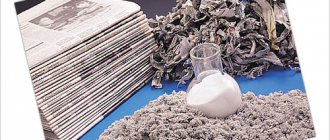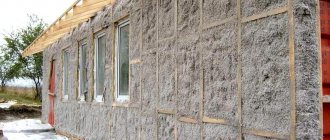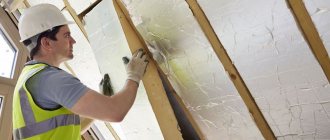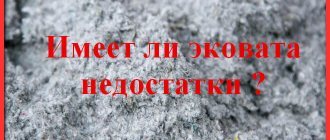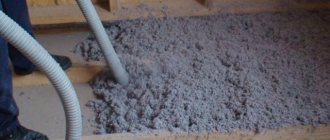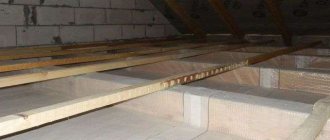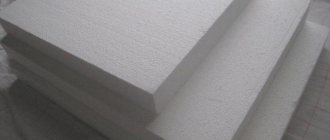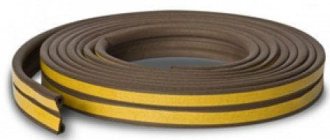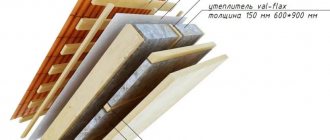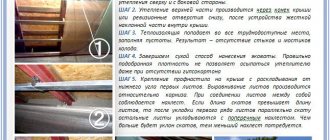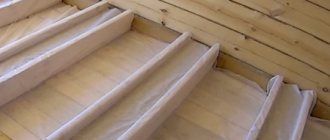Ecowool - disadvantages and advantages of insulation
Today, modern thermal insulation material – ecowool – is widely used in the construction of houses. Not everyone has a positive attitude towards the quality of ecowool as an insulation material. That is why, before using this thermal insulation material, it is necessary to carefully consider its main characteristics and properties.
- Ecowool - technical characteristics and properties of insulation
The essence of ecowool
The insulation is made from cellulose obtained as a result of secondary processing of paper. It is impregnated with fire retardants and boric acid, which prevents the fibers from getting wet and rotting. Ecowool is a sprayed product. Its advantages include:
- Low thermal conductivity;
- Resistance to wetness and mold development;
- High sound-absorbing characteristics;
- The sprayed application method eliminates the appearance of cold bridges due to the absence of assembly seams and voids.
The cost of the material is up to 35 rubles/kg, on average 1600 – 2600 rubles/m3 depending on the density.
Basalt insulation
A type of mineral wool. It is made from molten gabbro-basalt. The insulation comes in the form of slabs or mats.
Which is better: ecowool or basalt insulation?
Comparing these materials, let's consider their characteristics:
| Index | Ecowool | Basalts |
| Thermal conductivity, W/m*K | 0,038…0,041 | 0,037…0,044 |
| Density, kg/m3 | 30…75 | 35…190 |
| Shrinkage | No | Yes, voids form between the slabs |
| Vapor permeability, mg/Pa*m*h | 0,67 | 0,3 |
| Life time | Up to 65 years old | Up to 40...50 years (destroyed by mold and fungi) |
In terms of thermal conductivity, the materials are similar to each other; both insulate the indoor air well.
Density can be used to judge the mass of materials - basalt slabs have increased weight due to their mineral origin. Moreover, the value is influenced by both the composition and thickness of the insulating layer. Ecowool consists of light particles, so its mass is relatively small.
A significant difference is the shape of the insulation. Basalt mats and slabs are suitable for use only on flat surfaces; ecowool is able to penetrate into all cracks and voids of the surface, providing reliable protection.
Polyurethane foam, characteristics
Elastic polyurethane foam is a general name for a group of materials that consist of inert carbonate gases and air (the proportion of binder is from 5 to 15%, the rest is air space).

The commonly used name “foam rubber” appeared due to the fact that in the Soviet Union this product was represented by the products of the Norwegian company Porolon, which later merged with colleagues from Lithuania.
To determine the physical properties of a material, the following categories are used:
- average density (kg/cubic m) – 30-150,
- thermal conductivity coefficient (W/m*K) – 0.019-0.028,
- porosity – closed,
- service life – 20-30 years,
- operating temperature (°C) – from -160 to +150.
The density indicator characterizes foam rubber as a fairly soft material that is easily deformable and does not lose its integral structure. It is worth noting that the structure is more adapted to bending than to pressure. When compressed, polyurethane foam does not work correctly and quickly becomes unusable. In percentage terms, the permissible size reduction is 10%.
Thermal conductivity is the main advantage of foam rubber. The material has the smallest coefficient. This means that it warms up or freezes by only 2 mm, therefore, for high-quality thermal insulation a layer of 5 mm will be sufficient, and a layer of 10 mm will provide protection from the cold even in the most severe climatic conditions.
Closed porosity means that polyurethane foam is a solid material, the pores of which are concentrated inside.
Carbon, which is the basis of foam rubber, is one of those elements that practically does not disintegrate and only becomes stronger over time. In the case of polyurethane foam, this leads to crystallization of the structure and loss of heat-saving properties. However, even for inexpensive manufacturers the service life exceeds 20 years; if you buy modern products, they will last for 50 years. Such a significant increase in service life is achieved due to more thorough purification from various gas impurities. This type of polyurethane foam, the price of which is not significantly higher, by the way, is produced in Japan.
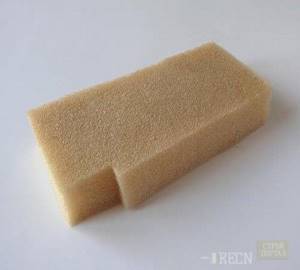
The maximum operating temperatures, as well as the thermal conductivity, are the highest among all thermal insulations. This is largely due to the fact that foam rubber does not heat up and cool down well, however, due to the presence of air in the composition, it burns very well and quickly. This is perhaps the only disadvantage of the material. Modern foam rubbers contain special inert gases-catalysts, which cause a carbon coking reaction, so fire spreads to the material only under the influence of an open flame. It is better to test this property by experience before purchasing.
Biological and chemical resistance should also be noted. In the first case, polyurethane foam is quite reliable, since it is not susceptible to rotting, mold and fungi, in addition, some components are harmful to rodents, so their appearance is excluded. The same is true for the roots of trees and grasses. For humans, foam rubber is no less dangerous; in small doses it causes “volvulus”, in large doses it is fatal. Therefore, small children should not be allowed to access the material.
Despite the fact that polyurethane foam is chemically neutral, acids and alkalis have a destructive effect on it, so it is not used at production facilities. Contact with detergents has no consequences.
It is not customary to talk about sound insulation in terms of foam rubber, since the material suppresses (removes noise, high frequencies, makes it duller), but does not muffle the sound. This property is successfully used for the production of headphones, pop filters and other audio equipment.
Comparison of ecowool with other insulation materials
To create a more complete picture of the qualities of ecowool, let’s consider its characteristics comparing with mineral and glass wool:
| Characteristic | Ecowool | Glass wool | Stone wool |
| Compound | Cellulose + antiseptics (boric acid and borax). Made from wood fibers. Natural material. | Particles of glass and quartz sand. Half artificial insulation. | Particles of lava rocks, mainly mining waste. |
| Chemical binders | Only borax and boric acid to prevent rot and mold. | Dyes. | No additives to prevent mold. |
| Fire resistance | Does not burn, does not support combustion. | It does not burn, but melts at high temperatures, releasing toxic substances. | It does not burn, but melts at high temperatures and releases toxic substances. |
| Shrinkage | If the technology is followed, shrinkage is minimal. | Slight shrinkage. | No shrinkage. |
| Moisture resistance | Absorbs moisture, but also dries quickly. | It does not absorb moisture, but when wet, it takes a long time to dry. | Does not absorb moisture, but takes more than 1 week to dry. |
| Soundproofing | high | low | High |
| Resistance to fungi and rodents | high | low | Low |
| Thermal insulation | High, no gaps | Low | When installed correctly, high |
| Price, m2 | From 250 | From 150 | From 250 |
A similar comparison of materials is presented in the video:
Reviews about ecowool are different, negative ones are mainly associated with myths:
- They are made from recycled newsprint, so the insulation is not durable and is harmful.
- Made by passing paper through a dust shredder.
- Unreasonably inflated price.
- Borax and boric acid in large quantities are harmful to health.
- If you burn it, it maintains combustion.
- Absorbs moisture well due to the cellulose component.
All these reviews have nothing to do with high-quality insulation manufactured using modern equipment.
Rid your home of rodents and insects
To permanently protect your home from the invasion of rats and mice, as well as insects, you do not need to use toxic chemicals - just insulate the house with ecowool, and these uninvited guests will lose interest in your home.
The fact is that both insects and rodents cannot live next to ecowool - they cannot tolerate the borates that it contains. Boric acid and its salts are non-volatile, resist fire, and are safe for humans. Consequently, the use of cellulose insulation allows you to solve a number of important problems:
- increased thermal insulation;
- increased sound insulation;
- protecting your home from rats and insects;
- protection from drafts;
- natural regulation of home humidity;
- absence of mold and mildew.
Not like fish in water
The relationship between moisture and insulating materials can be described as complex. Here we need to return to thermal conductivity again. Under normal conditions, as we have seen, this figure is approximately the same for different thermal insulators, but everything changes when moisture gets on the insulation. All materials behave differently. The most moisture-sensitive material is basalt mineral wool; when moistened by 1%, its thermal conductivity increases by 9–8%. Fiberglass also does not tolerate water well, but recently products with enhanced moisture resistance have begun to appear.
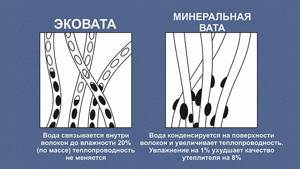
Moisture distribution inside ecowool and mineral wool fibers
What's going on with ecowool? It absorbs water, but thanks to the fibrous structure, all the moisture gets into the fibers, and the empty space with air (which is the main heat insulator) remains free, as a result, when humidified to 20%, the thermal conductivity remains unchanged.
Ultimately, the water resistance parameter is relevant only in the event of force majeure (roof leakage, waterproofing breakthrough, etc.). Subject to compliance with building codes and regulations, water should not get on the insulation, so this indicator should not become decisive when choosing a particular insulation material.
Maintaining humidity in the house
This property of ecowool is well known - natural regulation of humidity in the house. The process is ensured due to the properties of the insulation: it accumulates moisture when there is an excess of it in the air and releases moisture back when it is lacking, for example, during the heating season. By the way, ecowool absorbs moisture into itself, that is, moisture is absorbed into the fibers themselves, leaving the air between the cellulose fibers minimally humid, unlike mineral wool (if we return to the question: which is better - ecowool or mineral wool), and moist air is a conductor cold.
Comparative table of two insulation materials
In order to make a choice, it is recommended to familiarize yourself with the technical characteristics of the materials. This will help you decide which is more profitable: mineral wool or ecowool.
| Characteristics | Mineral wool "TeploKnauf" (loose) | Ecowool |
| Thermal conductivity (W/m*K) | 0.038 | 0,032-0,041 |
| Moisture absorption (%) | 0.5 | According to GOST 17177.5 for 72 hours - 16% (a block with heat-insulating material is placed over a container of water and kept for 3 days, after which it is weighed) |
| Density (kg/m3) | 11 | 30-55 |
| Vapor permeability (mg/(m*h*Pa)) | 0.3 | 0.67 |
| Flammability group | NG (non-flammable) | G2 (moderately flammable) |
| Density of connection to the structure | With voids | Absolute |
| Linear shrinkage | Interslab voids form | Absent |
When the humidity level of ecowool reaches 20%, processes begin to develop in it, leading to the appearance of mold. But at the same time, the material loses its thermal insulation properties by only 2-4%. The situation with mineral wool is sadder. With 1% moisture (by weight), it loses its thermal insulation properties by 8%.
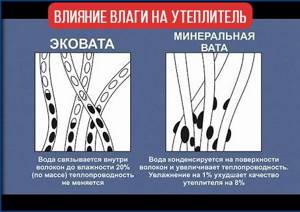
Insulation of houses with foam insulation
Thermal insulation with foam insulation justifies the cost of it in two, maximum three years. However, like any type of construction and installation activity, it requires certain knowledge, experience, and skills from the performers. An independent approach to insulation with penoizol will increase the expenditure part by at least two and a half times. Therefore, if you want to insulate your outbuilding, cottage or garage with this material, entrust this task to specialists with higher education. Do not trust companies with a dubious reputation, false reviews, or artificially low cost of services. And to make it easier for you to understand how to insulate your home with foam insulation, familiarize yourself with the basic principles of this work.
Insulation of walls with foam insulation
Thermal insulation with liquefied foam is carried out by filling the space between the outer and inner parts of the wall. If the house is built of brick, holes with a diameter of twelve to sixteen millimeters are drilled in the masonry. A hose is inserted into them, through which the liquid mass is pumped inside. The insulation is supplied using proven technology from the bottom up. Upon completion of the work, the previously made holes are sealed with polyurethane foam or an identical sealant on silicone or other components. The time required to insulate walls with an area of two hundred square meters is from six to eight hours, maximum.
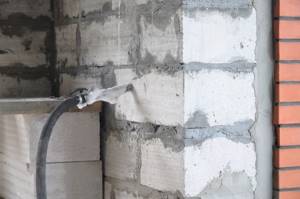
Insulation of roof and floor with foam insulation
The under-roof space is insulated using a vapor barrier material, which is very similar to the thermal frame technology. We have already written about it. Read it if you're interested. Penoizol is poured into the cavities between wooden blocks and covered with a film or vapor barrier membrane on top. If work is carried out on a roof that is in use, the set material is covered with oriented strand boards. Floors are insulated using the same methods as roofs. The insulation method is chosen based on the type of structure. The time spent on a thermal insulation event rarely exceeds an 8-hour day for a team, usually consisting of two people.
Combination of ecowool with various insulation technologies
There are two main technologies for insulating houses:
- Installation of an additional layer of insulation to the base material from which the shell of the house is built
- Incorporation of insulation into load-bearing structures.
Essentially, there are two options for building houses - from a monolithic material, such as brick, wall block or wooden beams, and from composite materials of walls and ceilings.
Monolithic materials are a good conductor of heat and, accordingly, do not retain heat well in the house. Additional insulation of monolithic walls is carried out by installing insulation from the inside or outside of the walls and ceilings.
It is obvious that insulation of monolithic materials with ecowool is possible only for horizontal surfaces - since ecowool in dry form does not hold on vertical surfaces, such as walls or roof slopes.
However, for this case, a roll-adhesive method of applying ecowool has been developed, which will be discussed below.
A different situation is observed in frame buildings. The insulation here serves as an element of frame blocks that ensure the structural stability of the frame.
In its most general form, the frame consists of hollow frames into which insulation is mounted and where it is held in place by sheathing sheets. Obviously, retaining bulk material between two partitions is quite possible. This has long been one of the ways to insulate panel houses, when loose insulation - from sand to expanded clay - was poured between two panels.

Filling ecowool into wall formwork
In general, it can be noted that ecowool insulation is possible for both technologies.
Density and weight
The higher the density of the insulating material, the greater its weight per unit area. With greater weight, the requirements for supporting structures increase. This is especially true when installing a roof. Also, in the case of ecowool, the density is affected by the uniformity of application.
Read about the features of choosing insulation for a roof in the article: “How to insulate a pitched roof.”
- Basalt mineral wool – 25 – 50 kg/m3 depending on the brand
- Fiberglass – 15 – 20 kg/m3
- Ecowool - 35 kg/m3 for horizontal structures and 65 kg/m3 for horizontal ones.
Thus, from the point of view of numbers, the materials do not differ much, but at the same time, applying ecowool to vertical surfaces with insufficient density can lead to subsequent shrinkage. Due to the specifics of application, the density in different areas is not the same.
In addition to a number of advantages, it also has its disadvantages:
- during operation, it can decrease slightly in volume, so when laying insulation, this must be taken into account and it must be installed with a slight excess of 20-25%.
- the insulation layer must be ventilated in order to be able to release the moisture accumulated in it into the atmosphere.
- It should not be installed on chimneys and fireplace pipes, since high temperatures can lead to slow smoldering.
When installing, be sure to pay attention to the main characteristics of ecowool: when installing it dry, dust is generated; when applying it wet, you will have to wait a long time until it dries completely. The wet layer can dry from 48 to 72 hours, which is not very convenient, but this method of application gives a better result - the layer is evenly compacted and this ensures a high level of thermal and sound insulation of the building.
Adhesion
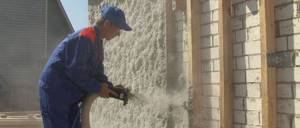
But for the insulation of ecowool ceilings and similar surfaces, the presence of lignin is no longer sufficient. To increase the adhesion of ecowool, during installation it is additionally moistened with a special adhesive solution. PPU has high adhesion to brick, wood, and concrete surfaces. It adheres equally well to paint, slate, metal and other substrates. The geometry of the surfaces - horizontal, vertical or inclined - does not matter.
Insulation materials
The use of ecowool when insulating a house has a large number of advantages, among which, first of all, are the environmental safety of this material and its ability to level any type of surface. There are several methods of insulation, which differ in the technology of applying the material to the surface. We’ll look further at how to insulate a house using ecowool.
Table of contents:
- Characteristics and features of ecowool insulation
- Ecowool photo, advantages and disadvantages
- Ecowool - use as insulation
- Methods of insulating a house with ecowool and their characteristics
- Do-it-yourself ecowool insulation: installation technology
Characteristics and features of ecowool insulation
Ecowool is a loose thermal insulation material, which contains a large amount of cellulose, about eighty percent, and additives in the form of various flame retardants and antiseptic components.
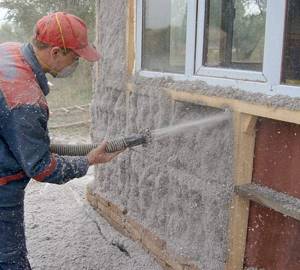
In addition, ecowool is distinguished by the presence of mineral salt, which has a strong antiseptic and antifungal effect.
Due to the fact that ecowool contains cellulose, it prevents heat loss and has good resistance to mechanical damage. After applying the material to the surface, a fairly durable seamless coating is formed, which serves as insulation.
Since cellulose is unstable to moisture, fire and microorganisms, additives are added to ecowool to improve its resistance to fungus and mold, as well as to increase its fire safety.
Most often, the following components appear in the form of such additives:
- the use of borax helps reduce the fire hazard of the material; after adding this component, ecowool is classified as a material of the second fire safety class; its use in the process of insulating chimneys or other areas exposed to high temperatures is unacceptable, however, in the process of insulating walls and ceilings it is ideal option;
- with the help of boric acid, rot of the material is prevented; in addition, ecowool becomes resistant to rodents and various kinds of insects, and its resistance to the spread of fungus or mold also increases.
We invite you to familiarize yourself with the technical indicators of ecowool materials:
- ecowool has a thermal conductivity coefficient of 0.038-0.041 W/mK;
- in relation to the installation method, the density of ecowool varies from 25 to 95 kilograms per cubic meter;
- the material belongs to the second class of flammability;
- In addition, ecowool is vapor-permeable and breathable at a fairly low level.
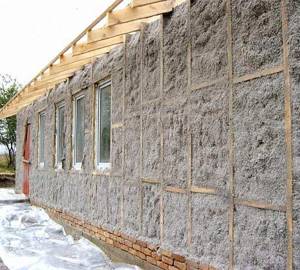
Ecowool photo, advantages and disadvantages
If we compare ecowool with other alternatives, such as mineral wool, expanded polystyrene or slag wool, then in terms of thermal conductivity, it is on the same level with them. Despite this, this material has clear advantages that set it apart from other insulation materials:
1. The ability to absorb and then evaporate moisture.
Despite the fact that the material has a low coefficient of vapor permeability, ecowool absorbs moisture quite well. If we compare it with mineral wool, which also has this property, ecowool, in the process of saturation with moisture, does not change the thermal conductivity and other physical characteristics. Even with 30% moisture saturation, ecowool can lose only 3% of its properties. At the same time, during the process of drying, moisture gradually evaporates from the material. If you install ecowool in a wooden house, it will become a natural regulator of the microclimate in the room; if necessary, it will take excess moisture from the air, and when the humidity decreases, it will release it.

Please note that installation of ecowool in rooms with high levels of humidity or in basement areas is unacceptable. Since the material will absorb a large amount of moisture without evaporating it.
2. Creation of a seamless thermal insulation coating.
Ecowool has the appearance of a loose, homogeneous mass, which is installed either simply by pouring or by using a compressor unit. In the process of high-quality installation of ecowool, a seamless ceiling is obtained, in which there are no cold bridges that worsen thermal insulation.
3. Excellent soundproofing performance.
Due to its low throughput, ecowool has good sound insulation properties, which means that after its installation you do not need to take additional care of sound insulation. Ecowool creates an atmosphere of coziness and comfort in the house.
4. Harmless to health and environmental safety.
This quality is the most important factor for choosing ecowool. This material does not contain phenol or other components that have a negative impact on human health. The use of borax and boric acid is safe, since they are not able to evaporate from ecowool.
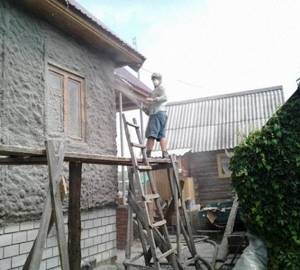
5. Using ecowool as insulation, you can significantly save on heating your home in the winter.
Despite this, this material has the following disadvantages:
- low vapor permeability, does not allow air to circulate normally in the room;
- If the technology for laying the material is not followed, ecowool is not able to properly perform its functions.
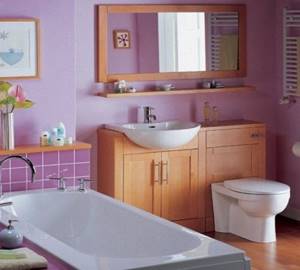
Ecowool - use as insulation
Due to the fact that ecowool has a huge number of advantages, its scope of application is quite extensive. Ecowool insulation is used for the following purposes:
- insulation of residential buildings, cottages, dachas;
- insulation of multi-storey public and residential buildings, especially important for multi-storey buildings located in a noisy city; ecowool protects them from noise;
- industrial or production sites;
- arrangement of retail outlets and warehouses;
- thermal insulation of swimming pools, baths, saunas;
- thermal insulation of cafes, restaurants, theaters, cinemas, etc.;
- Due to environmental safety, the use of ecowool is allowed in children's institutions such as schools, kindergartens, as well as in medical institutions, hospitals, and sanatoriums.
In addition, ecowool is used to provide good sound insulation in places such as recording studios and acoustic rooms.
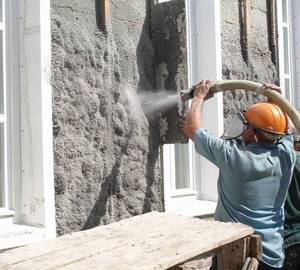
The room, for insulation of which ecowool was used, has optimal humidity, air temperature, and also does not contain harmful substances in the air. In relation to more specific areas, ecowool has found application:
- when carrying out thermal insulation work on facade areas, wet spraying is used for these purposes;
- in the process of insulating the walls of a room or building, it is possible to install insulation into the walls during their creation or after the construction of the house;
- to provide thermal insulation in the attic or on the roof, dry blowing is most often used for these purposes; ecowool is laid directly on the covering or on another type of insulation that has already been laid;
- Insulating the floor with ecowool allows you to achieve almost the same thermal insulation effect without installing a heated floor in the building;
- reducing heat losses in the attic; two methods are used for these purposes - hand laying on the floor, dry blowing on the walls.
Also, a dry plaster mixture is made from ecowool, which allows you to process brick, concrete or pre-painted surfaces, improving their heat and sound insulation characteristics.
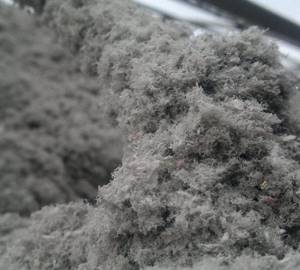
Methods of insulating a house with ecowool and their characteristics
Ecowool is produced in the form of a bulk substance, which consists of a certain amount of cellulose fibers. In order to improve the ease of transportation and storage of ecowool, it is produced in briquettes. After opening the package, ecowool increases in volume several times.
There are several methods of laying ecowool, which can be used to insulate certain areas of the building.
1. Installation of ecowool using the wet method.
This method of laying ecowool involves the use of a binder, namely lignin. With its help, ecowool is moistened and adheres well to the surface on which it is applied. Thus, insulation is formed, the density of which is about 53 kilograms per cubic meter.
This method does an excellent job of insulating block houses made of brick. Before applying the material, a lathing is made, which is based on a wooden beam or a steel profile. The material is applied using a special device that creates a certain pressure to supply it. In addition, during operation, the nozzle of the device should be moistened with water so that ecowool can be easily applied to the surface.
This installation method is characterized by ease of execution and good productivity. Among the disadvantages of its implementation is the need to purchase or rent a special device with which the heat-insulating material is supplied.
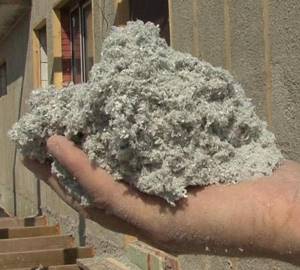
If it is necessary to insulate vertical surfaces or complex areas using the wet method, it is necessary to add special glue-based additives to the water with which the device is moistened. They will help improve the adhesion of the material to the surface.
Next, the material is cut in relation to the level and dried. Excess ecowool is used again to apply the material to other surfaces, while it does not lose its characteristics. Therefore, this method of laying ecowool is also called waste-free.
2. Ecowool installation using the dry method.
Another fairly common method of laying ecowool is its dry installation. To install ecowool, you only need a special attachment for a drill and the drill itself, which is used to fluff the material. To do this, the dry mixture is placed in a special container, and it is fluffed in it until it fills the entire space. Next, the ecowool is compacted until it becomes elastic.
The calculation of ecowool installed using the dry method is made as follows:
- m — ecowool consumption, required amount of material;
- g is the total area of the element that is subject to insulation;
- f—thickness of ecowool application;
- k is the value of the density of the material.
With horizontal distribution, the optimal density is 44 kilograms per cubic meter, and with vertical distribution - 64.

3. Industrial installation of ecowool.
This method is the highest quality and technologically correct, since ecowool is fluffed using special equipment, in the form of a compressor unit. Before this, the lathing is made, which is completely covered with film or craft paper. Next, ecowool is supplied to the surface with a special hose, so the material is evenly distributed over the entire surface and gets into even the smallest corners. After this, the hole is sealed and the installation of ecowool is completed.
Do-it-yourself ecowool insulation: installation technology
If it is necessary to use ecowool in small areas, it is allowed to lay it manually. Although this installation method has some disadvantages, since the quality of such insulation is an order of magnitude lower than that of ecowool laid industrially. Material consumption during manual installation of ecowool is much higher than during industrial installation. Despite this, this method has certain advantages. If you plan to thermally insulate a small area of the building, then you do not need to spend money on calling a construction team with special tools. One person is enough to complete the work.
To reduce the volume of packaging and to increase the convenience of transporting mineral wool, it is packaged compacted, that is, compressed. Therefore, before installing ecowool with your own hands, you should fluff it up, giving the material volume.
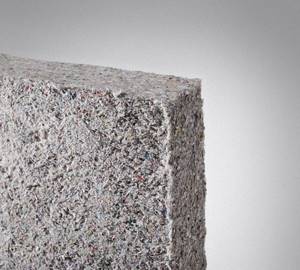
To insulate ecowool with your own hands, follow these steps:
1. Remove the ecowool from the packaging and place it in a specially prepared container. Using an electric drill and a stirring attachment, add volume to the ecowool. It should increase at least three times. The material is now ready for use.
2. The material is laid on a surface with a pre-laid vapor barrier or kraft paper. Ecowool is laid on the surface and leveled on it. Please note that the density of the insulation should be about 44 kg per cubic meter.
3. If you plan to insulate an interfloor ceiling or attic, then the thickness of the ecowool layer should be at least 18 cm.
4. After laying the material, you should leave it on the surface for two or three days.
5. When insulating the floor, ecowool is laid in layers, most often it is located in the space between the joists.
6. After installing the ecowool, you should lay thick paper on it, which will help compress the insulation.
Minvata
Mineral wool is one of the most common types of insulation for insulating various elements of a building, that is, insulation is laid in the roof, floor and interior floors, floors, walls, both inside and outside the room. Tiled or rolled mineral wool allows you to quickly insulate a house, bathhouse, and various utility and non-residential premises.
Such popularity of mineral wool is easily explained by the wide selection of varieties, brands, and availability in retail chains. Also low cost, ease of installation, high heat and sound insulation characteristics. But there is another side - a negative one, which sometimes outweighs all the positive qualities of many varieties and brands of mineral wool. The use of formaldehyde resins as a binding component to form an insulating layer significantly reduces its environmental friendliness, but reducing the component reduces the moisture resistance of the finished insulating material. Only some types based on basalt fiber do not contain harmful toxins. In its pure form, it is difficult to impart the required density to mineral wool; there remains a risk of dust from mineral fibers getting into the air of the insulated room, so it is mainly produced in rolls or mats with already formed density and rigidity.
Ecowool - comparison with other insulation materials

Comfortable microclimate
With a high heat-saving ability, ecowool can “breathe”. This effect is based on the natural property of the fiber, the capillaries of which, when humidity increases, absorb moisture (the space between the fibers remains dry), and when humidity decreases, they return moisture back into the room. Thus, the wall and ceiling always remain dry, and a comfortable microclimate is constantly maintained in the room. When insulating, films and expensive ventilation of rooms are not required.
A comfortable microclimate in a house insulated with ecowool is ensured by two main properties of the material: low air permeability and good vapor permeability/hygroscopicity.
Low air permeability is the merit of wood fiber in the insulation composition: the small size of the fibers effectively slows down the movement of air, unlike insulation with low density.
Ecowool is a hygroscopic, vapor-permeable insulation. Thanks to this, its humidity matches the humidity of the environment and, like wood, it is able to “breathe”. Consequently, houses insulated with ecowool can be built without vapor barrier.
In the event of a water leak or flooding, ecowool is capable of absorbing a mass of water 5-6 times its own weight - as a result, water does not enter other parts of the structure. When dried, the insulation does not lose its properties.
Ecowool can absorb natural moisture from a room when it is in excess and release it back without losing its heat-insulating properties, unlike other insulation materials. This is explained by the tubular structure of the fiber cells: it absorbs moisture, and the space between the fibers remains dry.
Ecowool is widely used for moisture insulation of rooms where condensation forms due to temperature changes.
Ideal for wood
Ecowool is insulation made from natural fibers. It is ideal for wooden houses and is designed to fill closed voids inside structures and open horizontal surfaces. It is suitable for insulating new and old houses where the wood often cracks, warps or forms an uneven surface - for example, in a log house. Conventional insulation in mats and slabs is not so easy to cope with these issues, but Ecowool insulation adapts to the cavity being insulated, regardless of its geometric shape. Insulation fibers can fill a cavity of any size.
The natural base of ecowool is the same as that of wood, so it fits perfectly with it and is suitable for insulating wooden houses and structures better than any other insulation! It is especially important that it makes up for the missing property in wood - heat conservation.
The uniqueness of ecowool is that it can be used to insulate wooden houses both outside and inside, maintaining the property of “breathing” and providing heat without any consequences caused by condensation - condensation simply does not form, just like in the wood itself. This is explained by the tubular capillary structure of natural fiber, in which steam easily escapes out and draws fresh air inside.
In wooden construction, it is imperative to use only natural insulation!
Simple proof: interventional insulation in both timber and log houses is always done only with natural insulation - tow, flax, jute and moss - and no other.
All attempts to use mineral wool insulation led to rotting of the wood and freezing of the roof joints due to the accumulation of moisture in these insulations.
Natural and environmentally friendly
Today society demands that products be harmless to human health. Ecowool is absolutely environmentally friendly, which gives it undeniable advantages over other insulation materials. It does not contain harmful volatile substances and phenol-formaldehyde binders, all its components are of natural origin, and the main component is pure fiber, the basis of wood.
Thermal insulation properties
High thermal insulation properties of the insulation are ensured by:
- good insulating ability of the air contained in the fibers and between the fibers;
- small air flow passing through the layer;
- fine-fiber structure;
- good thermal insulation ability of natural fiber.
The thermal conductivity coefficients of all insulation materials are approximately the same, and accordingly, the thickness of the required layer is also approximately the same. At the same time, there is an indisputable fact: any minor gap or crack in the layer gives a huge heat leakage. Tests show that any properly installed roll or board insulation produces 4% joint voids, which results in 25% heat loss.
The main advantage of ecowool compared to other insulation materials is the seamlessness of the layer, which allows you to save on house maintenance in the winter.
Noise protection
Sound is transmitted through gaps and voids in walls, floor and ceiling joints. Ecowool insulation creates a soundproof monolithic wall. In this case, thin fibers penetrate into the smallest elements of the insulated space. As a result, ecowool has excellent soundproofing properties.
- the standard airborne noise insulation index for the building envelope should be 60 dB;
- the actual index for a partition consisting of gypsum plasterboard - 100 mm mini-slab - gypsum plasterboard is 37 dB;
- the actual index for a partition consisting of gypsum plasterboard - ecowool 50 mm - gypsum plasterboard is 63 dB.
Accordingly, in a timber or wooden frame house insulated with ecowool, noise protection will be several times higher than the standard value.
Fire safety and non-toxicity
Ecowool insulation is a self-extinguishing material that does not support combustion. In the event of a fire, it retains its heat-insulating ability and prevents the spread of fire for a long time without emitting toxic substances.
Due to the presence of the natural mineral borax, ecowool has good fire-fighting properties. When a fire occurs, water is released from the mineral, which extinguishes the surrounding structure, effectively preventing the spread of fire. In addition, a layer of soot forms on the surface, which blocks access to oxygen and prevents ignition. When heated, ecowool does not emit toxic gases.
Protection of structures from rotting, fungi, insects and rodents
Ecowool contains imported boron salt antiseptics, which provides effective protection of a wooden house and its structures from rot, fungi, insects and rodents.
Ecowool is a bioresistant material. Moreover, it antiseptics structures:
- protects against destruction by microorganisms;
- provides effective protection against wood rotting, metal corrosion and sulfate corrosion of concrete;
- stops the growth of fungi;
- prevents the appearance of rodents and insects in insulated structures;
- prevents the formation of condensation, dampness and sweating of insulated structures.
Cost-effective and waste-free
Ecowool insulation monolithically and without seams fills all cavities, cracks, irregularities and takes on any shape of the structure. Ideal for structures with uneven thickness. The installation technology does not involve cuttings or waste.
Does not shrink at low weight
Ecowool is a bulk or blown-in natural insulation material, so when vibration is created, it only increases in volume, which has been experimentally proven. The material is lightweight: floors - 40 kg/m3, attics and walls - 70 kg/m3. This allows you to reduce not only the weight of the house itself, but also the load on its individual structures, foundation, and foundation.
Video description
The extent to which the positive characteristics of ecowool declared by the manufacturer correspond to reality is described in the video:
Flaws
There are no ideal materials without flaws, and ecowool is no exception. It also has its downsides.
- Shrinkage of the thermal insulation layer.
Over time, the loose fibrous material shrinks, becomes denser, loses volume, and its thermal insulation properties decrease. On horizontal surfaces, this problem is solved by making the layer thicker than the calculated one and organizing high-quality ventilation to evaporate moisture. But with vertical insulation, it will no longer be possible to fill the resulting voids.
- Installation problems.
When purchasing ecowool insulation, you should find out in advance what it is and where it is used. As well as the way in which it is laid on different structures. If you want to insulate monolithic walls or fill the cavities of a frame house, you will need special equipment and experienced operators, which are not yet available everywhere. And when insulating floors manually, the compressed material, freed from packaging, must be loosened using a drill with an attachment. This creates a lot of pervasive debris and allergenic dust.
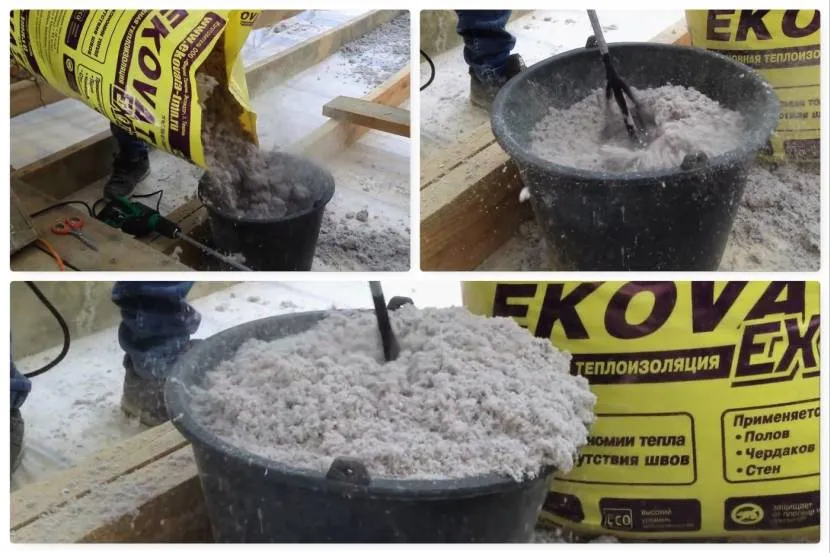
Before installation, the material is “beaten” with a mixer Source obustroeno.com
